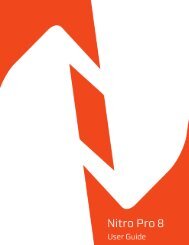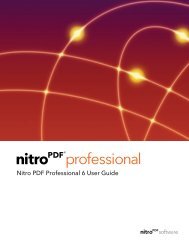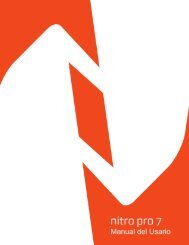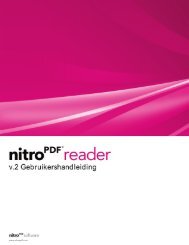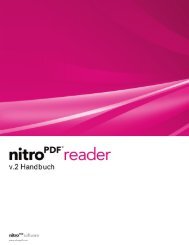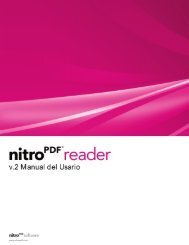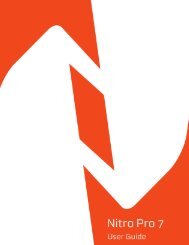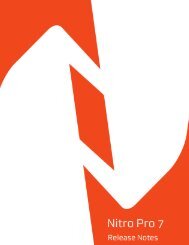Nitro PDF Professional User Guide
Nitro PDF Professional User Guide
Nitro PDF Professional User Guide
You also want an ePaper? Increase the reach of your titles
YUMPU automatically turns print PDFs into web optimized ePapers that Google loves.
38<br />
<strong>Nitro</strong> <strong>PDF</strong> <strong>Professional</strong> <strong>User</strong> <strong>Guide</strong><br />
Color space<br />
Watermarks<br />
See the Combining files & assembling pages section for editing pages.<br />
7.1 Undo/redo edits<br />
7.2 Text<br />
The new <strong>Nitro</strong> <strong>PDF</strong> <strong>Professional</strong> interface does not have the traditional Edit menu that contains the<br />
undo/redo functionality. Never fear, it’s still close at hand.<br />
How to undo/redo changes:<br />
1. Do one of the following:<br />
· Press CTRL+Z to undo, or CTRL+SHFT+Z to redo.<br />
· In the Quick Access Ribbon, in the top-left corner of the <strong>Nitro</strong> Pro window, click Undo or Redo.<br />
<strong>Nitro</strong> <strong>PDF</strong> <strong>Professional</strong> includes all the text-editing tools usually required for making last-minute corrections<br />
and updates to <strong>PDF</strong> documents, without the need to go back to the source files in Word, Excel, WordPerfect<br />
and so on.<br />
· Headers & footers<br />
· Bates numbering<br />
The Edit Text & Images tool is perfect for quickly fixing ‘typos’ and making minor formatting changes<br />
to text, as well moving, editing and deleting text and images in your <strong>PDF</strong>.<br />
Tip: If you’re planning to make many small or several major text corrections to a document,<br />
we recommend you go back to the source file and make the changes there—you’ll have more<br />
precise control over the exact layout and look, and there may be an opportunity to automate<br />
the corrections to save time.<br />
Edit Different Fonts<br />
The properties of fonts can vary significantly depending on the settings used during the <strong>PDF</strong> file's creation,<br />
and this can affect your ability to edit text at all in a <strong>PDF</strong>. In particular, <strong>PDF</strong> files containing subset fonts can<br />
be problematic when last minute edits are required.<br />
· Non embedded. These create the smallest file size because no fonts are embedded within the <strong>PDF</strong>.<br />
The tradeoff is that the <strong>PDF</strong> will most likely look different for different users. If you use common<br />
system fonts like Times New Roman, Arial, Times, Courier, and Symbol then you file will look pretty<br />
similar but if you use a font that your recipients do not have installed, then your document could look<br />
quite different to the file you designed.<br />
· Subset embedding. These embed just the characters from each font that appears in the source file.<br />
This means that only part of the whole font has been included and that if you try to type a character<br />
(e.g. X) that was not used in the document when it was created, it cannot be inserted into the<br />
document. The reason why people subset embed fonts is that they want their file to look exactly as<br />
they designed but they want it to be as compact as possible -- embedding a whole font can increase<br />
© 2008 <strong>Nitro</strong> <strong>PDF</strong> Software





